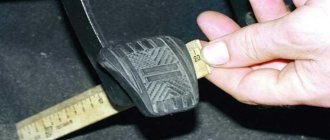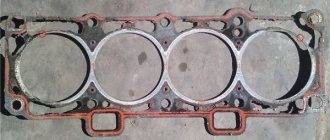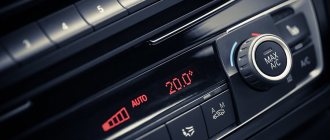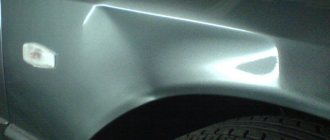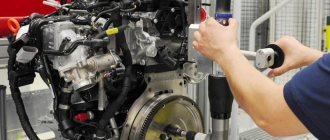About the brakes
At first, uninitiated glance, this is one of the simplest car controls. I saw an obstacle - I braked, something incomprehensible was happening ahead - I braked, poor visibility - I braked. But this can be done in different ways. If everyone is used to ABS, and it is literally on everyone’s lips, then the brake assist (BAS) system sometimes causes some confusion.
What happens when you press the brake pedal? Without considering in detail the operation of the braking system as a whole, we should simply note that the force generated on the pedal is transmitted to the brake pads, which causes them to operate, reducing the speed of the car. This is how it looks in its simplest form, but in modern cars - Mercedes, Nissan, Toyota and others, a similar process is much more complicated.
Its operation involves such components as ABS, which prevents the car from skidding, and EBD, which optimally determines the amount of braking force on different wheels, determined by driving conditions. But this, as it turned out, is not enough for timely emergency braking. Everything is quite simple - in order to ensure the greatest efficiency of the brakes, the pedal must be pressed quickly and completely. When a situation arises that requires an urgent reduction in speed, this is often done with a delay, especially by inexperienced drivers. To avoid this, the brake assist (bas) system is used.
How Brake Assist works
If you are driving along the road and suddenly an insurmountable obstacle appears in front of you, your instinct will be to press the brake pedal. But, as we wrote above, most often a person’s reaction is greatly delayed, so the pressure may not be strong enough. As a result, emergency braking will not work and you will crash into an obstacle. However, if your car is equipped with a Brake Assist system, it will instantly respond to pressing the brake pedal, independently reading readings from the sensors and determining that there is an emergency on the road. Within just a split second, a signal with the necessary instructions will be sent to the brake system and ABS, after which the car will perform emergency braking, even if you did not have time to react to the obstacle in time. Thus, you can understand that Brake Assist is a system that can analyze several important factors at once, including your reaction, driving speed, and the operation of the braking system.
Today there are several types of Brake Assist emergency braking systems. Volvo is working on an advanced safety system for city driving, called CSS. It works if the vehicle speed does not exceed 30 miles per hour. Mercedes offer the installation of a DP system, the principle of which is based on maintaining the distance to the nearest object ahead. Toyota installs its own system, which combines several elements of other electronic car safety programs.
About the work of BAS
In fact, BAS is a brake booster. Their work will be most effective when the pedal is fully depressed. However, it may take different times for different drivers to sink it completely. If the pedal is not pressed fully or not quickly enough, the stopping time increases. It is precisely the response speed, especially in emergency braking conditions, that BAS improves.
Thus, whether on Nissan, Toyota, Chevrolet or other modern cars, the most effective results can be achieved by simultaneous work:
- EBD, which distributes braking force between the wheels, the magnitude of which depends on the driving conditions of each of them;
- ABS, which allows you to avoid skidding on any surface;
- BAS, which works as a brake booster.
Brake assist is controlled by signals from a sensor located in the vacuum booster. It measures the speed at which the vacuum booster rod moves. If it moves quickly, which corresponds to a sharp press on the pedal, i.e. reaction to the unexpected occurrence of an obstacle on the way, the electromagnet is triggered, which causes an increase in the impact on the rod and acceleration of the brakes.
Their efficiency as a result of using brake assist improves by up to forty percent (braking distance is reduced), and in addition, the best conditions for using ABS are provided. Emergency braking support (brake assist) is especially useful for novice drivers who sometimes lack the ability to brake correctly, especially when driving at high speeds.
Brake assist, installed on heavy SUVs, such as Nissan, Toyota or similar, as well as on new modern cars, allows women or physically weak people to drive them, providing effective braking. It must be borne in mind that brake assist is only available on vehicles with ABS.
History of Brake Assist
In general, Brake Assist remains a rather controversial system. For example, many auto magazines even today shout incessantly that it is more like driving with a nanny who protects you even when the situation does not require it. But research and facts stubbornly say the opposite. Thus, eighty percent of drivers in an emergency either completely ignore the brake pedal, trying to “screw out” with the help of the steering wheel, or press the brakes not hard enough, in no way influencing the dangerous situation.
Don’t forget that the Brake Assist emergency braking system was introduced by Mercedes at the end of the last century. Even then it became revolutionary and unique in its kind. The first tests showed that Brake Assist is capable of reducing the braking distance of a car by almost fifty percent. At the same time, even the most experienced drivers before an accident are not able to react quickly enough to reduce the braking distance by at least ten percent of the average. But this is very important, because the shorter the car’s braking distance, the greater your chances of not getting into an accident and stopping on time even in those moments when a collision seems inevitable.
Undoubtedly, the opinion of the engineers themselves, who consider Brake Assist an excellent system that allows for more safety for the driver and passengers during emergency situations, remains important. At the same time, the system is adaptive, that is, it works depending on the actual performance of the brake system sensors. Electronics do an excellent job of understanding when the car stops at the driver's request (traffic light, parking) and when it comes to emergency braking (obstacle on the road, risk of collision).
Many manufacturers still refuse such systems, as they directly affect the cost of the car. Companies not limited to this, notably Mercedes, install Brake Assist on all their cars.
The first use of Brake Assist took place in 1996 on Mercedes S and SL class cars. Just two years later, after amazing results, the system was installed on all basic equipment of the manufacturer’s production vehicles. Within a few more years, the use of Brake Assist became quite normal for most major automakers, including Audi, Acura, BMW, Land Rover and Volvo. Many have developed their own analogues of the Mercedes system, improving them depending on the technical characteristics of their own cars.
BAS Service
The brake assist condition is diagnosed by the on-board diagnostic system, both on Nissan and on other modern vehicles. On a Mercedes, a sign of its malfunction can be the inscription on the display brake assist visit workshop, which translates as “emergency braking system, contact a service station.” In this case, the brakes themselves work normally, but the brake assist mode does not support emergency braking.
In some cases, the inscription recommending visiting a service station (visit workshop) disappears after restarting the engine, but if this happens, then soon the brake assist visit workshop invitation appears again.
It is quite difficult to establish the true cause of a failure without the appropriate diagnostic equipment, but it can be noted that the appearance of an invitation to a visit workshop maintenance station is most often associated with a failure or wear of the sensor. As already noted, if the brake assist fails, the braking system is used in classic mode, and the car retains the ability to brake.
Brake assist, used on modern cars, be it Nissan or other brands, is designed to provide assistance during a sudden drop in speed, can significantly reduce the braking distance for a vehicle and increase the safety of the driver and his passengers.
Brake Assist system
In order to understand how important the Brake Assist emergency braking system is, it is enough to imagine a completely ordinary road situation.
Let's say you're going somewhere outside the city. Good day, dry track and no problems. However, at some point, the car driving in front of you suddenly brakes, forcing you to press the brake pedal to the floor. At such moments, you begin to prepare for the worst-case scenario - a collision with another vehicle, that is, an accident. But, if you have the Brake Assist system installed, then everything will be fine - your car will stop quickly and sharply, literally a couple of centimeters from the other car, avoiding a dangerous collision. The fact is that modern sensors and electronics used in cars are, in any case, much more efficient than drivers. It's all about reaction - automation doesn't need time to think about the situation. The system simply takes readings from the sensors and acts according to the established program. At the same time, the Brake Assist emergency braking system, working in conjunction with other electronic safety elements of the car, allows you to stop even in those moments when a decision needs to be made in just a split second.
At the same time, despite the cries of many that Brake Assist is just a successful advertising ploy that allows concerns to sell even more cars around the world, special safety tests tell us something completely different. Judging by the test results, a modern emergency braking system is an irreplaceable thing that can save not only the car from damage, but also your life. Only according to the latest data, over 10 years of operation, Brake Assist was able to prevent hundreds of thousands of traffic accidents, which could easily have been fatal.
Installing the cable
The brake cable housing will be stopped inside the arc. The rod (arc) holds the shirt, and the cable passes through it to another bracket.
Once the shirt is fully secured in the bow and the bow is secured and seated in the joint, pull the arms towards the rim. Use a "fourth hand" such as the BT-2. Do not squeeze the tool with force, just tension the entire system. Secure the cable to the clamp bolt.
Brake assist emergency braking assistance system
Today, most premium cars are equipped as standard with Brake assist, BAS or EBA - an emergency braking assistance system. For those who are not fluent in English, the literal translation of Brake assist is “braking assistance.” Its main function is to reduce the braking distance during unexpected braking. Research shows that this system can reduce it by a fifth on average. This is sometimes enough to save a life.
There are two main types of Brake Assist - emergency braking assistance, and a more modern version - automatic emergency braking. The first one literally applies the brakes for the driver, releasing maximum pressure into the brake circuit (including “anti-lock”). The second one performs a similar operation, but practically without the participation of the driver himself. Let's look at each in more detail.
Brake Assist
Typically, systems of this kind are divided into hydraulic and pneumatic. This classification is based on the principle of creating maximum pressure in the brake circuits. Pneumatic Brake Assist allows you to achieve maximum efficiency for the vacuum booster. These systems include:
- BA (Brake Assist itself),
- BAS (almost the same name as Brake Assist System),
- EBA (Emergency Brake Assist) is installed in Mercedes, Volvo, Toyota, BMW,
- AFU (l'aide au freinage d'urgence), installed on the “French”, on Citroen, Renault, Peugeot.
From a design point of view, they combine a special sensor, an electromagnetic rod drive, and a control unit for the entire system. In almost 100% of cases, the pneumatic variation of any Brake Assist is installed on cars equipped with ABS. The “assistant” begins to work only at the moment of sharp (emergency) pressing of the pedal. A special sensor reads the speed at which the brake pedal is pressed, and then this information enters the aforementioned control unit. That, in turn, turns on the electromagnet, and the vacuum amplifier “presses” the pedal all the way. All this happens before the ABS is activated.
The hydraulic version of the system in question allows you to create maximum fluid pressure in the brake circuit using structural elements of ESP (exchange rate stability system). It also has many versions: HBA, SBC, HBB, BA Plus, DBC. The operating principles of these systems are similar, but it is better to consider them in more detail.
- HBA (Hydraulic Braking Assistance) is installed on Audi, Volkswagen,
- HBB (Hydraulic Brake Booster) also on Audi, Volkswagen,
- SBC (Sensotronic Brake Control) is installed on Mercedes cars,
- BA Plus (Brake Assist Plus) also on Mercedes cars,
- DBC (Dynamic Brake Control) is an abbreviation for BMW.
HBA, like its pneumatic counterpart, recognizes an emergency situation by the speed at which the pedal is pressed. The system uses an angular velocity sensor, a brake light switch, and a brake circuit pressure gauge. After analyzing the data, the control unit decides to turn on the return pump, which maximizes the brake fluid pressure. The entire process occurs before ABS is turned on.
HBB sometimes literally duplicates the operation of an ordinary vacuum brake booster, for example, when warming up a car in winter. The system uses data from the brake pressure gauge, brake light switch and vacuum sensor in the aforementioned vacuum booster. If the vacuum in it is not enough, then a signal is sent to turn on the return pump, which significantly increases the pressure in the brakes.
SBC is an advanced version of the brake “assistant”, which takes into account a wide variety of characteristics and factors, ranging from the speed of the foot transfer from gas to brake, the force and speed of pressing the pedal, and ending with the type of road or dynamic parameters. Based on all these factors, the ideal pressure in the brake circuit is calculated for each situation that arises on the road.
BA Plus is something intermediate between automatic and manual assistants. The program reads the distance to oncoming objects (thanks to Distronic radars), including cars on the road, signals the driver about danger and requires them to slow down. If the braking seems insufficient, BA Plus will independently increase the pressure in the circuits.
Automatic Emergency Braking System
These systems are technically more advanced and are installed only on very expensive cars in the maximum configuration. The organs of “vision” are radars or video cameras. The system independently calculates the distance to the vehicle in front and reduces speed. Even if this does not prevent the collision, the damage will be significantly reduced. Typically, this system is based on other safety systems, for example, adaptive cruise control. There are many types of automatic braking assistant; as a rule, the car manufacturer itself gives it a name. For example, Pre-Safe Brake for Mercedes, or CMBS for Honda. Some other options:
- City Brake Control for Fiat,
- City Emergency Brake for Volkswagen,
- ACS and Forward Alert for Ford,
- FCM on Mitsubishi,
- City Safety and CWABrake on Volvo,
- as well as AEB from TRW and PEBS from Bosch.
In addition to the obvious function, the above-mentioned systems have a number of other capabilities, including sound and light signaling or alerting passive safety equipment.
Caliper installation
V-Brakes attach to the same frame fittings as the cantilever brake. There needs to be some lubrication on the outside of this surface so they can run smoothly. The recommended treatment for the fastening bolt is to apply a medium consistency thread locker. Apply thread locker to the inside of the fitting threads.
Brake calipers have a spring that fits into one of three possible frame/fork mounts. The topmost fitting provides high spring tension. Typically the middle hole is chosen, also make sure both sides are symmetrical and in the same middle hole.
Mounting bolts are screwed into each direction. Typical torque for mounting bolts is 8 Nm.
Centering
Place the pads in the center of the rim. Use the set screws on the sides of the calipers to center the pads to the rim. The levers move with the adjustable screw. Tightening the centering screw increases the tension of the return spring. Loosening the centering screw relaxes the spring. Adjustments can be made from either side.
Brake Assist
Imagine this situation: one wonderful day you decided to go visit your friends. You're heading down the highway, your favorite music is playing, a nice warm breeze is blowing on your face, in general, life is wonderful. And so, you are in a great mood, eating, enjoying life, when suddenly the car in front of you suddenly brakes. Naturally, you press the brake pedal and are already preparing for the worst.
Fortunately, everything worked out, your car stops a few centimeters from that same car. You breathed a sigh of relief. But everything could have ended completely differently if the Brake Assist system had not been installed in your car.
Compared to modern electronic sensors, we have a rather slow response, and Brake Assist and its accompanying technologies help stop the car earlier - sometimes those split seconds make a big difference.
So, is Brake Assist a truly worthwhile safety system or is it just another clever marketing ploy to sell more cars and another money grab? Numerous studies have shown that Brake Assist is actually worthwhile, as it prevents thousands of major fatal accidents every year.
Why is Brake Assist and how does it work?
What if all the electronics that activate the system are too sensitive and result in stalls that jerk every time the driver presses the brake pedal? Auto magazines have long railed against these electronic nannies.
Research shows that most drivers are unable to control their brakes in emergency situations. According to Mercedes-Benz, in an emergency situation, 99 percent of drivers either do not press the brake pedal firmly or press it too late.
Mercedes introduced Brake Assist technology back in the late 90s, at which time the manufacturer stated that Brake Assist helps reduce braking distances by 45 percent. Moreover, even for experienced drivers, when driving a car without this auxiliary system, the braking distance is reduced by only 10 percent. The shorter the braking distance, the lower the chances of becoming involved in an accident.
Automotive engineers call Brake Assist an adaptive driver-adaptive system. In other words, the electronics that control the operation of Brake Assist are connected to the braking system. Brake Assist distinguishes between stopping at a traffic light and emergency braking, say, when a child runs out into the road.
Sometimes automakers refuse new safety systems because their installation affects the cost of the car itself. As we already said, Mercedes-Benz, together with parts supplier TRW /LucasVarity, developed the Brake Assist system.
The technology first appeared on the consumer market in 1996 on the Mercedes-Benz S-Class and SL-Class. In 1998, the company began offering the system as standard on all of its models. Soon, some companies such as Acura, Audi, BMW, Infiniti, Land Rover, Rolls Royce and Volvo developed their own versions of Brake Assist.
Now let's imagine another situation: you are driving along a deserted country road on a moonless night, there is a forest all around, and suddenly a deer runs out onto the road.
As soon as your foot instinctively presses hard on the brake pedal, the sensor instantly determines that this is an emergency by the reaction and force of pressing the pedal. Within a fraction of a second, the sensor transmits a signal to the brakes, and those in turn - to the brake calipers, the anti-lock braking system (ABS) is activated, the speed slows down, the car stops, and not a single deer is hurt.
Today there are several types of Brake Assist. Volvo offers a “City Safety system” that operates when the car is traveling at speeds up to 30 km/h, Mercedes-Benz has developed Distronic Plus, which maintains the required distance from the vehicle in front, Toyota offers a system that which combines Brake Assist and navigation data (Brake Assist is activated during emergency braking at a traffic light).
Active Brake Assist is a newer technology development that helps fill the brake system with hydraulic pressure milliseconds before an impending accident. The technology provokes a sharp decrease in speed when braking and the car stops faster.
Bosch, a German parts supplier, has unveiled its version of the technology - Predictive Brake Assist, which works in tandem with adaptive cruise control, whose radar detects the possibility of a collision. The system, having determined the distance to the object ahead, begins to lightly press the pads against the discs.
The company says this innovation is necessary because in an emergency, only about a third of drivers react in time and press the pedal with sufficient force. In other cases, the hydraulic brake assist system does not operate.
